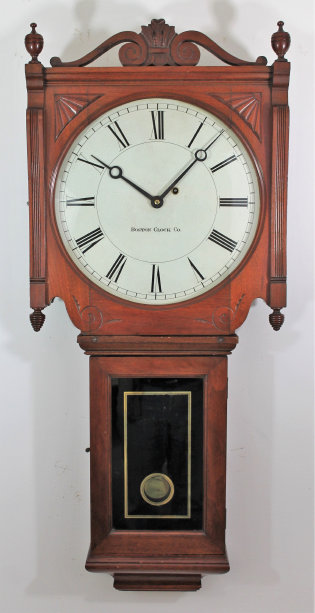
527. $1200
Seth Thomas “Office Calendar No. 1”, 1869. A large (40-inch) and iconic Seth Thomas calendar
clock in very good condition. The rosewood veneer is dark and rich and the painted dials are clean and chip-free. The
day and month roller covers are complete (and old). There are good labels inside and a card that shows the date the clock was
set at the factory in 1869. The 8-day weight-driven movement is oily and runs tentatively, stopping after 10-20 min; it will
need attention if you wish to run this clock. The calendar mechanism is functional. We do not have the male key for the
door lock, but an Allen wrench will work if you wish to lock the door. This is one of the nicer looking examples of this model
that we have seen. We sold one in 2017 for $2000. $1200-$1800
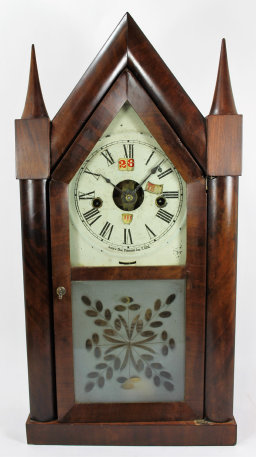
528. $350
Chauncey Jerome “Seem’s calendar” steeple, ca. 1870. Josiah K. Seem invented a calendar dial
that could be used on any clock with a simple addition to the main stem. He is associated with the Macomb Calendar Clock Co. This 20-inch steeple was made by C. Jerome in New Haven and contains a double fusee movement and the Seem calendar dial. The
8-day time-and-strike movement is signed and running, striking, and keeping time, and the calendar is advancing. The dial is
signed “Seem’s Dial, Patented Jan 7, 1868”; it is soiled and will not easily clean. There are three windows through which the
day, date, and month show in worn and chipped red lettering. Both the top and frosted bottom glass are old and likely original. The veneer is in fine shape, there is a torn label inside but the maker and location are clear. A rare clock. $350-$500.
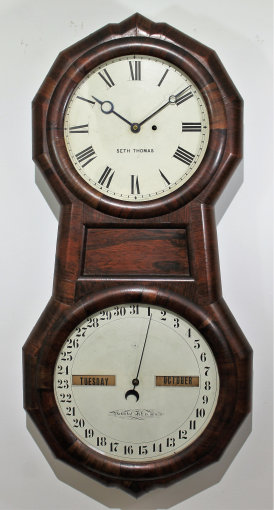
529. $275
Waterbury “Galesburg”, ca. 1906. A 52-inch case, dark with decades of wax and dirt. They
made this clock in oak or mahogany, I can’t rule out oak, but it looks like mahogany under the grime. A paper dial, correct
hands and all correct finials, a possible replacement pendulum and bob. The door glass is old and possibly original. The
8-day spring-driven, time and half-hour strike movement is signed and running, keeping time. Good label on the back. If
you wanted to put some effort into cleaning the finish I suspect you would be rewarded with a fine-looking clock. $300-$500.
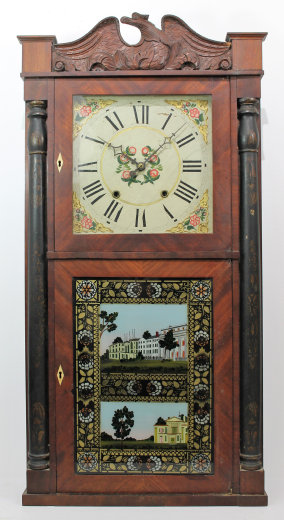
530. $475
Marsh, Gilbert & Co. 8-day clock, 1832-1834. These guys were together for just two years,
manufacturing 30-hr and 8-day wooden works clocks. As noted on the label, this one uses ivory bushings. The massive iron
weights are over 13 lb each and are compounded on wooden pulleys. A note with the clock explains that very heavy weights were
needed to drive the clock, as it used essentially a 30-hour movement with small spindles and long cords. We did not test the
movement. The wooden dial is nice, with minor losses around the 1; hands are appropriate and period. The lower glass was
nicely repainted in the door, no signature. The dial glass is cracked and also original, with the original putty holding both
glasses in place. The bronzed columns still show the original design and the carved eagle splat looks original. No veneer
losses that I can see, making for a very attractive 8-day wooden works clock, 36.5-inches high. Pretty good label inside. $500-$800
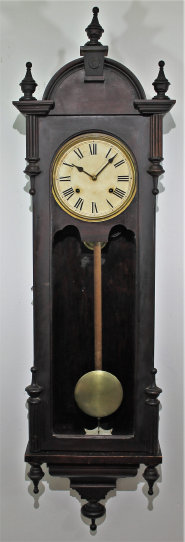
531. $600
Ansonia “Capitol”, ca. 1901. Ansonia made three slightly different versions of the Capitol
over 20+ years; this is the last version; they also made spring and weight-driven versions. This one is in black walnut with
a nice finish; the finials are correct but probably reproduced, as is the crest. The glasses are old, the dial is glossy paper,
the hands correct. Note the seconds bit. This example is weight-driven, time-only, 8-day, and the movement is signed and
running. I can’t be sure the weights are original and the pendulum and bob are strongly suspect. Nonetheless, a nice-looking
clock, 54 inches tall. The weight-driven versions seem to be less common than the spring-driven versions. $600-$900.
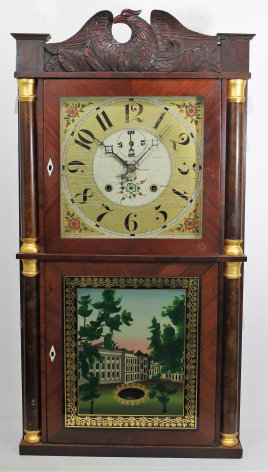
532. $450
Seymour, Williams & Porter 8-day clock, 1832-1839. These three worked out of Farmington,
CT. This two-door case is 35 inches tall with good mahogany veneer all-around. This clock has had some restoration: the
carved eagle splat is newer; the tablet was nicely repainted on new glass; the columns and capitals have been repainted. I think
it looks great, but grunge isn’t my thing. The dial shows a lot of “stretch marks”, but is colorful and I don’t believe I’d
replace it. Note that there is a seconds bit on this clock, not common on wooden works clocks. The movement looks fine
but we didn’t test it with the two old unmatched weights. I have run 8-day wooden works clocks and they keep remarkable time,
but I find that they are sensitive to humidity and temperature. $450-$800.

533. $1400
Seth Thomas “Regulator No. 9”, ca. 1896. This 48-inch clock came in walnut or cherry; this
one is walnut with a very nice finish. It has a signed, painted metal dial with some scrapes and dents; it looks like it was
taken from another clock and soldered into this bezel. The time-only movement is unsigned (not uncommon), driven by an appropriate
brass weight. The pendulum bob is nickel, damascened, with some surface corrosion when viewed closely. It’s too bad (but
not uncommon) that the weight is not also nickel-plated. The door glass is not old and there is no label; we have seen the lack
of a label before on this model. It is running without problem and keeping time. $1400-$1600.
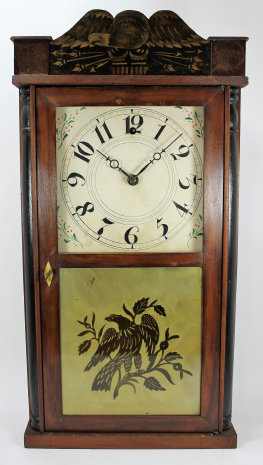
534. $300
Hoadley 30-hour shelf clock, ca. 1825. This miniature (24-inch) 30-hour wooden works shelf
clock is attributed to Silas Hoadley but we can’t prove that, as there is no label. It holds an unusual upside-down movement
(winder at the top) with the weight cord running up the right and out across the two top pulleys to descend on the left with the 3-lb
lead weight. Why the weight is strung in this way isn’t clear, as the same amount of weight-travel would be obtained simply
by running it down the right side. Note also that the escape wheel is at the bottom of the movement – this movement is truly
upside-down. You might think he was using a standard case and adapted it to this movement, but even that appears not to be true:
the movement is shifted to the left to accommodate the right-sided mainstem and winder. This makes for a narrow weight chute
on the left, where the weight travels. Again, why not use a heavier weight and a compounded cord in the now widened right channel,
giving more than 30 hr per winding? The logic in the design of this clock is not obvious to us. The dial has been repainted
and both glasses are newer, with some kind of full-glass decal on the lower glass. A repainted quarter-column on each side and
a possibly re-stenciled splat leave little unretouched detail to this unusual clock, and there is nothing similar in the Antique Clocks
Price Guide. It is running and keeping time. $300-$600.
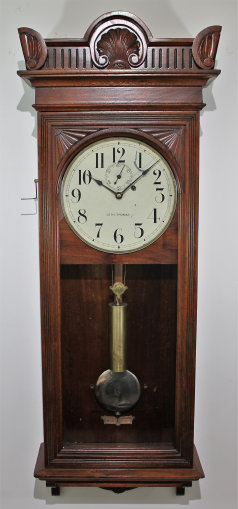
535. $4000
Boston Clock Co. office regulator, 1888-1897. Well, it looks like a Howard No. 75, doesn’t
it? There are two similar examples in the Antique Clocks Price Guide, one of which sold at Schmitt’s in 2008 for $17,000. We won’t be that optimistic, but this is a darn nice clock. The 40-inch case is cherry with a nicely rubbed finish. Both
glasses are old, the 14-inch dial repainted some time ago. The weight-driven movement is unsigned but is numbered; the
weight is unmarked. The weight shield is a replacement, the pendulum tie-down was retained. The pendulum bob is typical
of the Boston Clock Co. but there is no label. The top left scroll shows a repaired break and the top left finial is held in
place with sticky putty; the center trim piece appears to be a replacement. We assume this was a special order, as nothing similar
is shown in the catalogs for BCC or the Chelsea Clock Co. The clock is running and keeping time. $5000-$8000.
Side view Open Interior Movement Back

536. $125
E.C. Brewster shelf clock, 1836-1839. This 23.5-inch rosewood-veneered case contains a brass
8-day spring movement probably manufactured by Charles Kirke; it has an iron backplate and enclosed brass springs. There is
card label inside and an early pendulum bob. The metal dial is yellowed, the hands appropriate to Brewster. The lower
rosewood panel is probably a later replacement for a mercury mirror, and the dial glass is newer. The door locks with a brass
escutcheon and key. There is some missing veneer, some repairs, and some loose pieces. Significant for the early brass
movement. $150-$200.
